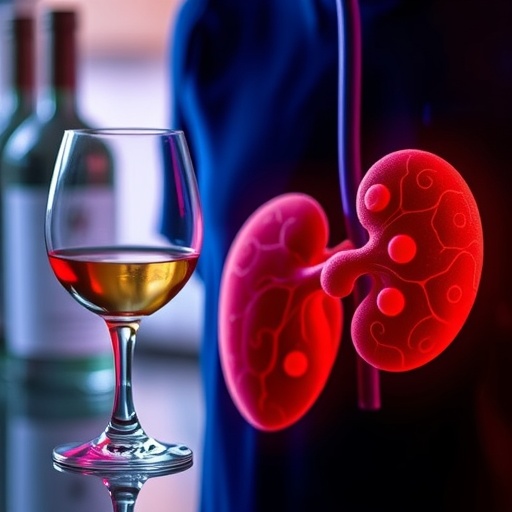In the ever-evolving landscape of university student behavior, heavy episodic drinking remains a persistent and alarming public health concern. Recent research spearheaded by Mejía-Trujillo and colleagues offers new insights into the intricate determinants driving this behavior among young adults on campus. Utilizing the comprehensive I-Change Model, the study breaks down the multifaceted psychological and social mechanisms that contribute to binge drinking patterns. This approach sheds unprecedented light on why certain students engage in high-risk alcohol consumption, pinpointing leverage points for intervention that extend beyond traditional prevention strategies.
Heavy episodic drinking, commonly characterized by consuming large quantities of alcohol within a short timeframe, has been linked to numerous adverse outcomes including academic decline, increased accident rates, and long-term health complications. Despite ongoing efforts to curtail such drinking behaviors, university students continue to represent a high-risk group. The study incorporates a robust framework combining predisposing factors, motivational drivers, awareness levels, and societal influences to unpack the complexity underlying this phenomenon. By operationalizing the I-Change Model, the researchers mapped out how various cognitive and environmental elements dynamically interact to shape alcohol consumption behaviors.
A crucial aspect of this research lies in its methodological rigor. Through quantitative surveys and behavioral assessments conducted within diverse student populations, Mejía-Trujillo et al. were able to identify not only risk factors but also protective variables that modulate the likelihood of heavy episodic drinking. The model emphasizes the role of intention formation, whereby beliefs and attitudes about alcohol influence the decision-making process prior to drinking episodes. Additionally, it incorporates habit formation and situational cues, highlighting how entrenched social norms and peer dynamics sustain harmful drinking routines.
.adsslot_2CtQaDdGmb{ width:728px !important; height:90px !important; }
@media (max-width:1199px) { .adsslot_2CtQaDdGmb{ width:468px !important; height:60px !important; } }
@media (max-width:767px) { .adsslot_2CtQaDdGmb{ width:320px !important; height:50px !important; } }
ADVERTISEMENT
Equally important is the study’s emphasis on awareness—how well students recognize the consequences of their drinking choices. The I-Change Model posits that awareness serves as a prerequisite for intentional behavior change; lack thereof may inhibit efforts to reduce risky alcohol use. The findings suggest that many university students exhibit low levels of perceived vulnerability, despite being exposed to frequent negative outcomes from binge drinking. This gap underscores the necessity of enhancing educational campaigns that not only convey statistical risks but also personalize potential adverse effects in a relatable manner.
Social context emerges as another pivotal determinant. Peer influence and the overarching campus culture are potent forces shaping drinking behaviors. The research articulates how group norms and social identity can either exacerbate or mitigate tendencies toward heavy episodic drinking. University environments that glorify alcohol use create compelling pressures for conformity, while those that foster alternative social engagements offer protective buffers. This insight calls for a broader ecological approach to prevention, encompassing policy reforms, community mobilization, and peer-led initiatives.
Psychological predispositions, including underlying stress, anxiety, and coping styles, also intersect with alcohol use patterns described in the study. The authors highlight that students relying on alcohol as a self-medication tool are particularly susceptible to episodic overconsumption. This intersection between mental health and substance use necessitates integrated intervention strategies addressing both domains. By aligning preventative efforts with mental health services on campus, the potential to disrupt maladaptive drinking patterns significantly increases.
Importantly, the study delineates the role of self-efficacy in moderating heavy drinking behaviors. Students who possess greater confidence in their ability to refuse drinks or manage social pressures tend to engage less frequently in binge episodes. This psychological dimension resonates strongly with behavior change theories and suggests that empowerment through skills training and resilience building could be a transformational component of future programs designed to reduce harm.
The temporal aspect of drinking habits receives particular attention, emphasizing how heavy episodic drinking is not a static behavior but one that fluctuates depending on situational triggers and life transitions. For example, exam periods, social holidays, and initiation events are identified as critical windows where risk surges. Interventions that target these temporal peaks with timely messaging and alternative activities promise more effective engagement than generic, year-round campaigns.
Mejía-Trujillo et al.’s research further challenges the simplistic binary view of drinkers versus non-drinkers by revealing a spectrum of drinking intensities modulated by interrelated psychological and social factors. This nuanced portrayal helps dismantle stigma and encourages more tailored treatment options. Recognizing that motivations for drinking are diverse, ranging from social facilitation to emotional escape, the study advocates for personalized approaches embedded within the I-Change theoretical framework.
Another compelling dimension of this work is its contribution to predictive modeling in public health. By quantifying the relative influence of various determinants, the I-Change Model assists in forecasting which student populations are at greatest risk based on psychosocial profiles. Such predictive capacity enables more strategic allocation of resources and proactive outreach, moving prevention from reactive to anticipatory paradigms.
The application of this model also underscores the value of interdisciplinary collaboration, blending insights from psychology, sociology, epidemiology, and behavioral science. The integration of these disciplines fosters more comprehensive understanding and intervention designs that resonate with the complex realities of student life. This multidisciplinary perspective is crucial as universities continue grappling with the persistent challenges posed by alcohol misuse.
As university administrations worldwide face mounting pressure to curb harmful drinking, this research offers actionable intelligence. It lays groundwork for policy architects to refine campus regulations in ways that reduce environmental risk factors without alienating students. For example, limiting alcohol availability during high-risk events or promoting alcohol-free social gatherings aligned with student interests could be impactful strategies derived from these findings.
Moreover, the study’s focus on cognitive antecedents of heavy episodic drinking invites innovation in digital interventions, such as mobile apps and online platforms tailored to bolster self-awareness and resistance skills. Technological tools can harness real-time data to deliver personalized feedback and support, enhancing the reach and effectiveness of traditional counseling methods.
Ultimately, the value of Mejía-Trujillo and colleagues’ work lies not just in mapping determinants but in charting pathways to change. The I-Change Model’s comprehensive approach provides a scaffold for multi-level, evidence-based strategies that hold promise for reducing the public health burden of heavy episodic drinking among university students. As institutions strive to foster healthier campus cultures, these insights illuminate the intricate interplay of cognition, environment, and social dynamics that underpin alcohol use behaviors.
The study’s implications extend beyond immediate university contexts, offering conceptual frameworks potentially applicable to other youth populations facing similar challenges. By advancing both theoretical understanding and practical interventions in tandem, this research marks a significant stride in the ongoing quest to curtail excessive alcohol consumption and its ripple effects on health, safety, and academic success.
With growing global attention on mental health and addiction in younger demographics, this research serves as a timely reminder of the need for comprehensive, theoretically informed models that capture the complexity of behavior change. As universities seek to implement holistic wellness programs, the integration of the I-Change Model offers a promising avenue to foster sustained reductions in heavy episodic drinking and thereby enhance the overall quality of student life.
Subject of Research: Determinants of Heavy Episodic Drinking Among University Students
Article Title: Determinants of Heavy Episodic Drinking Among University Students, an Application of the I – Change Model
Article References:
Mejía-Trujillo, J., Candel, M., Mercken, L. et al. Determinants of Heavy Episodic Drinking Among University Students, an Application of the I – Change Model. Int J Ment Health Addiction (2025). https://doi.org/10.1007/s11469-025-01529-8
Image Credits: AI Generated
Tags: academic impacts of heavy drinkingaddressing high-risk drinking in college environmentsbehavioral assessments in university researchbinge drinking behavior in young adultscognitive factors in alcohol consumptionhealth risks associated with binge drinkingheavy episodic drinking among university studentsI-Change Model and alcohol consumptionintervention strategies for alcohol misusepsychological determinants of binge drinkingpublic health concerns in higher educationsocial influences on student drinking patterns





